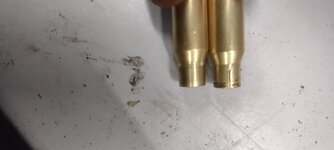Has anyone on this reloading forum noticed a difference in brass life between factory brass, and the same brass neck turned?
Details: splits at the case mouth has always been the failure mode at end of life for my 308. No biggie.
I did an experiment with neck turning and ended up with a couple hundred cases that are neck turned do a wall thickness of 0.0140 ~0.0145. standard dimension thickness is 0.015 so really what I'm doing is removing the high spots.
The brass pictured has been fired several times and I anneal every other loading. It had been fired at least twice before I neck turned it.
So that's the reason why I'm asking this question. I don't have enough data to know what to expect.
So once again all I want to know is whether anyone has data on brass life stock, and neck turned just enough to clean up.
Separate and apart from the question:
What I found is neck turning is not magic. If you think you're going to take Lapua brass and make it shoot way better by neck turning, you probably aren't. What I DID find helpful was making medium quality brass better. Every now and then, the neck turning device would cut a LOT of material off, frequently off just one side of the case mouth. That's even on once fired or New brass. Basically the brass manufacturer had dimensional flyers way different from the other cases.
So using a really good rifle, extreme precision and attention to detail on the bench, 5 shot groups proved nothing. BUT ten and twenty shot groups were measurably better several times with the nt cases. Basically the worst outlier shot was 0.25 to 0.35 more when the neck was fat on one side. One case threw a bad shot and one side of the neck was 0.017+
I cannot prove statistically exactly how much the neck turning helps. My undersized sample says maybe 0.2 inches with a base group of 0.7 under very ideal conditions. On Lapua brass I could not conclude anything.
Now I neck turn for only the heavy varmint gun. But I'll use turned brass in any rifle. That's where I landed. And I'll be moving to premium brass because turning is a pain.
Details: splits at the case mouth has always been the failure mode at end of life for my 308. No biggie.
I did an experiment with neck turning and ended up with a couple hundred cases that are neck turned do a wall thickness of 0.0140 ~0.0145. standard dimension thickness is 0.015 so really what I'm doing is removing the high spots.
The brass pictured has been fired several times and I anneal every other loading. It had been fired at least twice before I neck turned it.
So that's the reason why I'm asking this question. I don't have enough data to know what to expect.
So once again all I want to know is whether anyone has data on brass life stock, and neck turned just enough to clean up.
Separate and apart from the question:
What I found is neck turning is not magic. If you think you're going to take Lapua brass and make it shoot way better by neck turning, you probably aren't. What I DID find helpful was making medium quality brass better. Every now and then, the neck turning device would cut a LOT of material off, frequently off just one side of the case mouth. That's even on once fired or New brass. Basically the brass manufacturer had dimensional flyers way different from the other cases.
So using a really good rifle, extreme precision and attention to detail on the bench, 5 shot groups proved nothing. BUT ten and twenty shot groups were measurably better several times with the nt cases. Basically the worst outlier shot was 0.25 to 0.35 more when the neck was fat on one side. One case threw a bad shot and one side of the neck was 0.017+
I cannot prove statistically exactly how much the neck turning helps. My undersized sample says maybe 0.2 inches with a base group of 0.7 under very ideal conditions. On Lapua brass I could not conclude anything.
Now I neck turn for only the heavy varmint gun. But I'll use turned brass in any rifle. That's where I landed. And I'll be moving to premium brass because turning is a pain.

